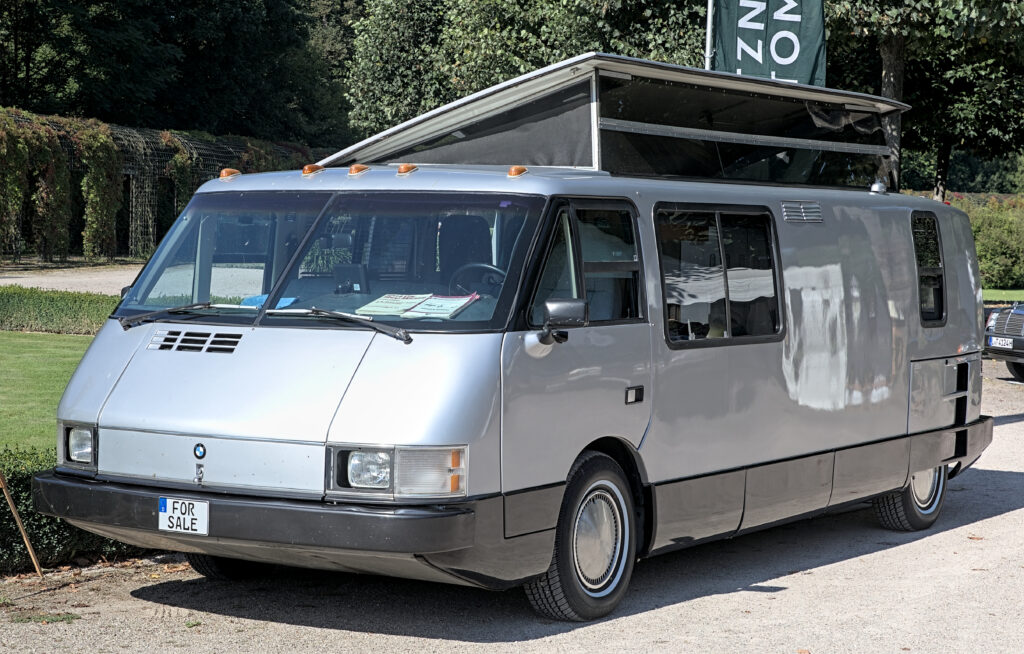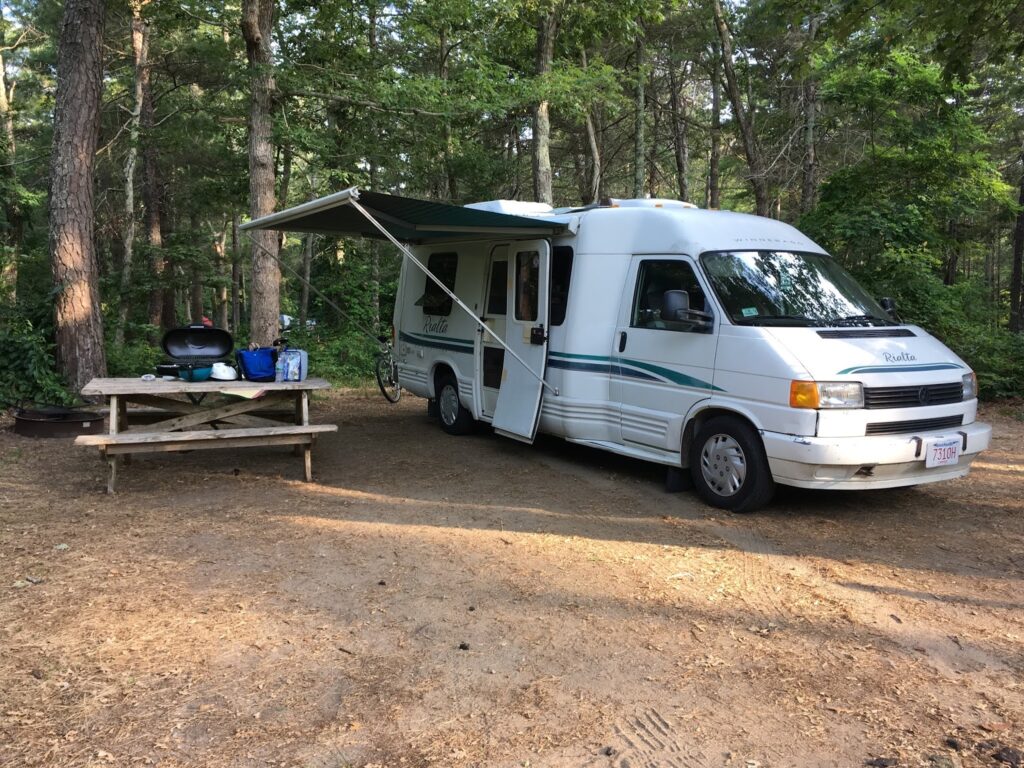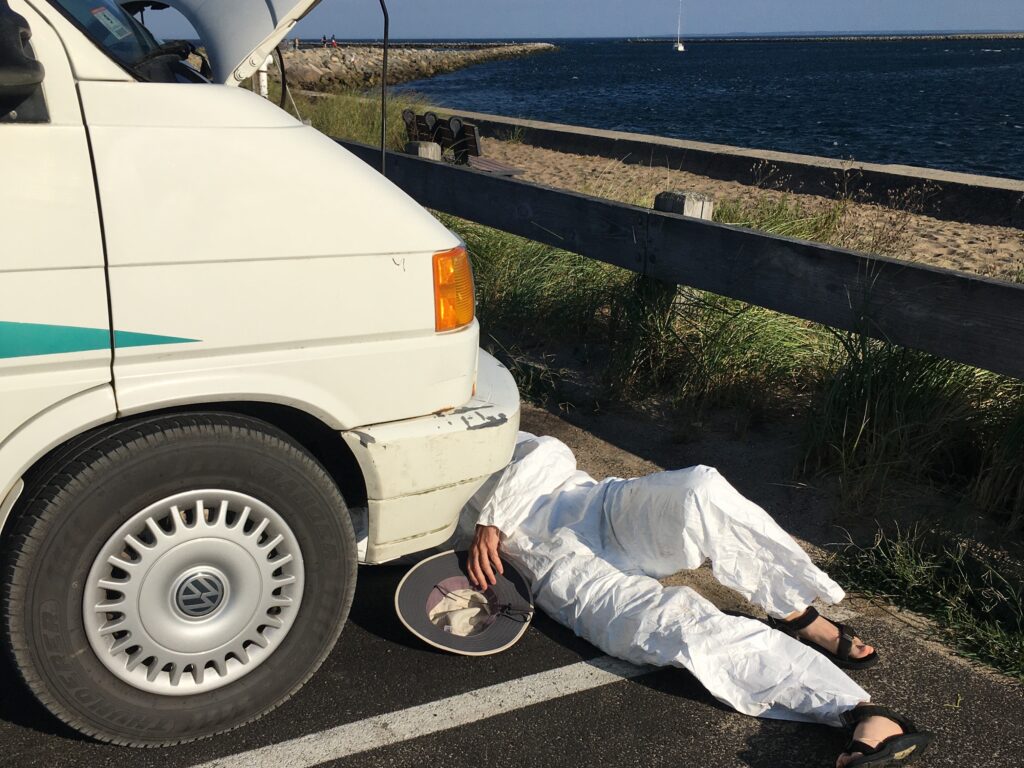Up until yesterday, I owned 13 vehicles. I count them as the nine cars on my Hagerty policy (the three 2002s, the E9, the Bavaria, the ’79 Euro 635CSi, the Lotus Europa, and the ’99 Z3 2.3 and the ’99 M Coupe), the two daily drivers (my 2003 E39 530i stick sport and my wife’s 2013 Honda fit), the tow vehicle (the 2008 Nissan Armada I’ve barely used), and the outlier—the 1996 Winnebago Rialta, which is a Volkswagen Eurovan with a Winnebago camper body on the back.
Longtime readers will know that there’s BMW-related history to my ownership of the Rialta. Eight years ago I went to Denver on my final geophysical survey for my former career. While I was out there, I came up with the idea that my wife Maire Anne and I should buy an value-priced project RV, as that would enable us to do the big western national park road trip that we’d long talked about, and to dovetail that with seeing our son Kyle who lives in Santa Fe. However, the idea of owning and driving a big gas-guzzling RV drove me crazy. I learned that there were basically only three small fuel-efficient RVs: 1. the multiple varieties of the Toyota mini-motorhome built from 1972 through 1994, 2. the wildly in-demand and unapproachably pricey Winnebago Rialta from the late 1995 through 2004, and 3. the Vixen—the boutique BMW-powered RV built in the late 1980s. As a BMW guy, the Vixen quickly became the target of interest for me.
Only 576 Vixens were built, just 376 of which—the 21TD—were the motorhomes powered by a BMW M21 turbodiesel engine and have a 5-speed manually-shifted transaxle. The TDs have been so accepted into the BMW fold that you see many of them with blue-and-white BMW badges affixed to their noses and tails. Make no mistake, Vixens are not BMWs. In addition, they’re weird little RVs. 21TDs were designed for fuel efficiency, interior space maximization, and the ability to pull into a standard garage, so they’re low and don’t have a rooftop a/c unit. Walk-around headroom is provided when parked by a tilting roof, sort of like an old pop-top VW camper except that it tilts to the side. They don’t even have a propane tank, instead providing coach heat through a Webasto heater that burns diesel, and cooking capabilities via an alcohol-fueled stove. But the combination of the Space: 1999 exterior and the undeniably appealing mid-century modern design aesthetic inside certainly does make them unique.

The Vixen 21TD. Note the BMW badge that isn’t supposed to be there on the nose. (photo WikiMedia)
So I became interested in finding one. Coincidentally, on the weekend I drove from Denver to Santa Fe to visit my son Kyle, I saw an ad on Craigslist in Albuquerque (just an hour south) for a Vixen with the two-word description “It’s trashed.” I had images of buying it, having it towed to my son’s in-law’s place in Santa Fe, sort it out, and driving it home. But it turned out to be a rodent-infested pile of junk (you can find Part I and Part II of the story “The Vixen That Wasn’t” hosted on the BMW CCA site).

“Trashed” accurately described The Vixen That Wasn’t.
My favorite part was how, when I sent photographs of the jury-rigged-looking steering column and a second column lying on the floor to a Vixen expert, he replied “Neither the steering column installed in the car nor the one on the floor go to the Vixen.”

Totally not joking about the steering column. Both of them.
The episode, did, however, start the wheels turning on both the whole buy-a-needy-vehicle-and-road-trip-it-home thing as well as the RV thing. Later that winter, I bought Louie the ’72 2002tii and did the whole Ran When Parked adventure with it. And early that summer, I found a nearby Rialta that was needy enough to put it into my bottom-feeding price range.
Like the Vixen, the Rialta is small, but it’s closer to being a conventional RV in that it has a rooftop air conditioner, a generator, and an internal propane tank. However, ours was a ’96, which meant that instead of the more-powerful Volkswagen VR6 engine like the ones from ’97 and on, it had the 5-cylinder 2.5-liter 110-hp Audi engine. That may have been adequate to move the 4,500-pound VW Eurovan, but stretched to 21 feet, with the Winnebago aluminum body on it, and with all the RV accoutrements, the Rialta weighs in around 7,000 pounds, so ours was as slow as the VW campers of yore (of which we owned two). Partially because of this, the idea of doing a big western road trip in the Rialta went out the window. However, it found an incredibly appealing niche taking us for three or four days at a time to campgrounds on Cape Cod where we could be a close to the beach for $40 a night. And, at only 21 feet long, it could be parked anywhere, making it so Maire Anne could say “Ooooh, that’s an interesting-looking antique store” and I could pull in without needing trucks with WIDE LOAD signs preceding and following me.

The just-purchased Rialta nestled among the tiis.
I soon found out, though, that owning an old RV means talking all the issues of an old car and adding the issues of an old house. To make matters worse, this one was built on a Volkswagen Eurovan, which, let’s just be honest, was hardly a poster child for reliability. Just about every outing we took was accompanied by my fixing something. While much of this was trivial (although I’m not sure my wife would categorize having to bail out the shower pan with a plastic bag as “trivial”), some of it was not. Having the alternator die was handled easily enough by tying the coach batteries (which were continuously charged by the solar panel I’d installed) to the vehicle battery. Popping a rear brake line on the approach to the Borne Bridge, though, was hair-raising. The only other vehicle I ever burst brake lines on was the last Suburban, a problem so common that there was a class-action suit. On the Rialta, the issue was that Winnebago plumbed the brake lines for the stretched chassis using corrugated metal tubing that provided a thousand little crevices for rust to fester. I’ve owned 70 BMWs over the last 42 years, most of them 1970s-era cars, and had zero burst brake lines. It figures that the brake line that popped on a German car was the part that was added by an American RV manufacturer.
Nonetheless, my wife and I both loved our beach outings in the Rialta. Even having nothing to do with camping or road trips, simply owning a vehicle with a bathroom and a stove in it was life-changing. Early on in our ownership, we drove to the beach, went for a hike, and got caught in drenching soaking rain. To be able to come back to the RV, stand upright while we changed into dry clothes, use the rest room, and make hot tea made me think that off all the niche vehicles I’ve come home with, this one was actually useful. Plus, Maire Anne is a fabulous cook, and she took pride in whipping out the collapsible Coleman stove and whipping up meals that would shame many a restaurant. And after dinner, a campfire, guitars, one too many glasses of wine for her, one too many drams of Islay scotch for me, the back of the RV and the incredibly comfortable Tempur-Pedic mattress pad I installed only four steps away… it became our new vacation rhythm for the next six years.

My wife’s incredible cooking graced many a picnic table.
A few things made me start to think about selling it. We didn’t use it at all last summer due to Maire Anne’s surgery and recovery. It just sat in the driveway. Its only outing was being pressed into service last winter to move a bed that our son Ethan had bought. Then, when I started it up a few weeks ago, it stumbled, then died while I was driving it. I recalled that this had happened during several other spring revivals in the past. A few years back I’d traced the problem to a cracked ignition coil pack, but I’d replaced that. I had a spare, so I swapped it anyway, no change. And one of the quirks about this Rialta was that it was an early one, a ’96 built on a ’95 Eurovan chassis, so it was too old to have the standard OBD-II diagnostic connector that’s in every car built since 1996, so there was no way (well, no easy inexpensive way) to plug in a code reader or scan tool to see what was ailing it. I did discover that the new alternator didn’t self-excite (didn’t begin outputting 14 volts to the battery) until the throttle had been blipped, and it’s possible that turning on the air conditioning to test it dragged down the voltage levels and caused the car’s ECU to flip out. I also found that the ground connections to the chassis and block were a bit dirty. After addressing both of those issues, the rough-running and dying didn’t return, but I was never certain that I’d really gotten to the bottom of it. I usually ridicule people for the whole “I’m selling it because I don’t trust it anymore” thing, and that alone wasn’t the issue. It was more that the totality of the vehicle’s maintenance needs were out of balance with the vehicle’s nonexistent usage. Plus, on paper, it seemed silly to own both the Rialta and the Armada, as if we wanted to hit the road, I could always buy or rent a travel trailer and tow it with the Armada.

I would’ve preferred to be enjoying the ocean view rather than trying to diagnose a bad alternator.
The death knell, though, was perhaps something almost embarrassingly bourgeois. Before Maire Anne’s procedure, I wanted to take her somewhere special, so we rented an Airbnb in Truro on the north Cape, one of the iconic former artist cabins right on the water. Eating our meals with the ocean 30 feet away was gorgeous, addictive, and eye-opening. During the 30 years we took the family on beach vacations in Nantucket, we rented a house that had enough space for our family and friends and was a staging point for beach assaults but was affordable because it was inland and wasn’t the kind of place that would ever be featured in Architectural Digest. And that was fine. But the place in Truro was my first experience where the real estate itself could be the destination. In other words, how are you gonna keep them down in the RV once they’ve stayed in beachfront Airbnbs?

The interior of the Rialta was welcoming and comfortable, but…

…I mean, come on.
But even the vehicle’s lack of use, the reliability specter (I mean, neither of those affect my ownership of most of my other cars) and the distraction of eye-candy vacation rentals might not have shown the Rialta the door. There was another factor. Although we loved our little getaways in the Rialta, most of the destinations in an RV are either campgrounds that cater to tenters and people in small campers or pop-up trailers, or RV parks designed for bus-sized RVs or long travel trailers. These two types of sites generally have different vibes. Campgrounds are usually leafier, whereas RV parks are often unbroken expanses of concrete. We could reserve sites for the Rialta at both, but we felt most at home in campgrounds. But even there, the Rialta’s tiny size (it’s said that RVs are like boats in that you always wish yours was four feet longer) and its shower that’s barely big enough to hose off a toddler meant that we usually used the campground facilities. While that was fine, it begged the question of whether Maire Anne and were really “RV people.” If this question is framed in this sort of a binary form, the answer, really, is “no.” I kept thinking that the Rialta would find other uses—that we’d take it to a music festival, or embark on the big pipe dream of hitting the road as singer-songwriters, but that never happened.
So I let it go. I wrote up my customary crushingly-detailed description, photographed it, researched asking prices on Craigslist, Facebook Marketplace, and the Rialta forum on Facebook, and priced it to sell. A Russian gentleman gave me a deposit, explaining that he wanted to use it to move his 90-year-old mother from Houston to his sister’s house in Vermont. I was my usual candid self and offered that that might not be the best mission for the vehicle—that, while it was currently running well and had working air conditioning, relying on those things wasn’t a bet I’d make with my own mother. He thought better of it and I returned his deposit. But a day later, it was purchased by a young car-savvy man who wanted to have adventures with his two boys. When he came to pick it up and I stepped through all of the RV systems to assure him they were all working, the generator leaked gas onto the driveway. Fixing it was trivial, requiring just cutting the split section of hose off, but it was an ending that perfectly represented the Rialta’s unending maintenance needs.

That new hose clamp ain’t there to pretty-up the neighborhood.
So, long may you run, Rialta. May the road rise to greet you, may your transaxle never overheat, and may you not get mashed flat by a semi if you’re doing 35 mph up one of those long hill climbs over the Rockies.
I may, of course, keep my eye open for something else. Hey, the Vixen That Wasn’t is probably still sitting in Albuquerque.
—Rob Siegel
____________________________________
Rob’s newest book, The Best of The Hack Mechanic, is available here on Amazon, as are his seven other books. Signed copies can be ordered directly from Rob here.
Tags: Rialta rv people selling





















